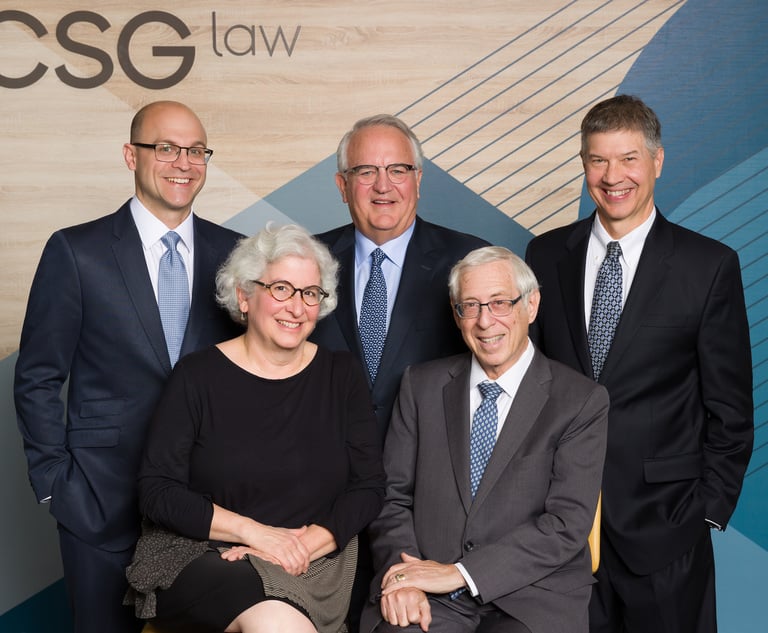 Credit: Robert Kneschke/Shutterstock.com
Credit: Robert Kneschke/Shutterstock.comThe Significance of 'US Masters v. NJDEP'
The recent split decision of the NJ Supreme Court, in this Spill Fund case after Superstorm Sandy, contains lessons for all NJ practitioners, especially environmental specialists.
September 19, 2019 at 12:00 PM
12 minute read
The recent split decision of the Supreme Court of New Jersey in US Masters Residential Property (USA) Fund v. New Jersey Department of Environmental Protection, (A-78-17)(081137), 2019 WL 3402917; ___ N.J. ___ (2019), contains lessons for all New Jersey practitioners, especially environmental specialists. In a 4-3 decision, the court reversed and remanded for further arbitration the judgment of the Appellate Division, which had affirmed the rejection by the DEP (or the "Department") and an arbitrator of a property owner's claim for reimbursement from the New Jersey Spill Fund for damages sustained allegedly as a result of the inundation of contaminated flood waters during Superstorm Sandy.
The various decisions were described by Lewis Goldshore in an article that appeared in the August 15 edition of the New Jersey Law Journal. In this article, the author hopes to add some additional thoughts for consideration.
To summarize, claimant's five adjoining residential properties located near the waterfront in Bayonne were flooded in October 2012 during Hurricane Sandy. Under the Spill Compensation and Control Act, 58:10-23.11 et seq. ("Spill Act" or "the Act"), the legislature has directed DEP, in response to a discharge of hazardous substances, to quickly deploy funds to compensate injured parties and restore the environment. That did not happen here.
After Sandy, claimant promptly filed a claim with the Spill Fund, asserting that the hurricane had discharged petroleum-based contaminants onto its properties, rendering them inaccessible and uninhabitable. Based on personal observations of "bathtub rings" and laboratory analyses showing naphthalene and moderately elevated levels of petroleum hydrocarbons, claimant's expert report concluded that oil had been deposited throughout the properties during the hurricane.
Following two DEP denials of the claim on the grounds that no hazardous substances were discharged, arbitration before an Administrative Law Judge took place two years later. In a report submitted just before the beginning of the arbitration hearing, the DEP's expert opined that the contaminants on claimant's property were non-petroleum hydrocarbons, historic fill and, as noted for the first time, Diffuse Anthropogenic Pollution (DAP). The arbitrator admitted this report into evidence, but excluded claimant's responsive expert report. Following five days of hearings, the arbitrator rejected claimant's Spill Fund claim, concluding that claimant failed to establish by a "preponderance of the evidence that damage to its property was caused by a post-[Spill] Act discharge of hazardous substances." The arbitrator further concluded that DAP, having been deposited over a long period of time into the sediment at the bottom of nearby waterways, and not oil, had been churned up during the storm and deposited onto claimant's properties.
In an unpublished per curiam decision, the Appellate Division upheld the arbitrator's decision. The court accepted his determination as to the source and non-hazardous nature of the contamination. It also concluded that, even if the arbitrator had misinterpreted the laboratory data and technical opinions introduced into evidence, claimant had failed to sustain its burden to establish a post-Spill Act discharge of hazardous substances. The court similarly deferred to the arbitrator's evidentiary rulings, finding no error in his admission of DEP's belated report and the exclusion of claimant's hastily prepared response.
The Supreme Court voted unanimously to grant certification. The court's opinion concluded that the arbitrator took out of context the opinion of DEP's expert that DAP from nearby river sediment had been discharged onto claimant's property during the storm. The court reasoned the expert was not discussing DAP when he opined about the materials constituting the contamination. It also criticized the arbitrator's exclusion of claimant's second report from evidence, pointing out that the DEP's expert report submitted shortly before the commencement of arbitration introduced a new theory of contamination—DAP.
The dissenting opinion would have sustained the arbitrator's decision to exclude claimant's second expert report. It reasoned that the report, which included the results of new sampling, was not intended to address the DAP theory expressed in the DEP's expert report but, rather, to attack the DEP's original bases for denying the claim, and therefore was untimely. The dissent also disagreed with the court's conclusion that the arbitrator had misconstrued the causation theory advanced by the DEP's expert. The dissent concluded it was reasonable for the arbitrator to infer that DAP from nearby sediment was mobilized during Sandy and deposited onto claimant's properties. Moreover, since claimant's laboratory evidence and expert testimony failed to establish oil contamination, claimant had failed to meet its burden of proof. As the dissent saw it, the arbitrator's theory of causation was "inconsequential."
|The Importance of a Persuasive Petition for Certification
One might ask, what compelled the court to review a highly fact-based technical decision where the DEP, arbitrator and Appellate Division all reached a similar result? In a sense, the case presented no novel legal issue, and Spill Fund law is neither unsettled nor in conflict. R. 2:12-4. The court's opinion reveals, however, that, although sensitive to the environmental considerations, it may have been concerned about more fundamental issues. Resonating in the opening pages and throughout the opinion are the court's concerns about the conduct of the DEP and the fairness of the arbitration.
The underlying claim arose as a result of Superstorm Sandy, an event from which reverberations are still being felt. Storms like Sandy are likely to occur with increasing frequency as a result of global warming. The properties are located in a "working class neighborhood of Bayonne" (Petition for Certification at 2), implicating considerations of environmental justice. Other properties in this area also were affected by the storm, and their owners have filed Spill Act claims, raising the question of the precedential effect the US Masters decision could have on such claims. Altogether, these considerations likely enhanced the court's concern about the fundamental unfairness of DEP's handling of the claims at the administrative level, and the arbitrator's conduct of the hearing.
Both the legislature and New Jersey courts have sought to facilitate the remediation of environmental contamination. See, N.J. Dep't of Envtl. Prot. v. Dimant, 212 N.J. 153 (2012); Pfizer v. Employers Ins. of Wausau, 154 N.J. 184 (1998). One purpose of the Spill Fund is to assure the prompt remediation of damage caused by discharges of hazardous substances. N.J.S.A. 58:10-23.11a. A related goal is to compensate victims of a discharge of hazardous substances deriving from an unknown source. N.J.S.A. 58:10-23.11m. Shoring up the concern about the fairness of the conduct of DEP and the arbitrator, the court likely perceived the thwarting of these judicial and legislative goals. As indicated, resonating throughout the majority opinion are the court's polite but palpable misgivings about the unfairness of the proceedings below and the resulting denial of due process. The court apparently felt the need to carefully scrutinize the record in an administrative proceeding where the arbitrator may have both misunderstood the proofs and failed to afford the claimant sufficient opportunity to make its case, thus strongly implicating "the interests of justice." R. 2:12-4.
|The Importance of a Prompt Hearing
The court recognized that the proceeding before the DEP and the subsequent arbitration took too long. Following DEP's two rejections of the claim, the request for arbitration was filed one and one half years after Sandy. Two more years elapsed before the start of the arbitration proceedings. DEP's expert first visited the properties more than three years after the storm, and the absence of an odor of oil and oil staining so long after the storm likely did not accurately reflect the conditions that existed in its immediate aftermath. As the court further noted, the submittal of DEP's expert report on the eve of the arbitration was unfair. DEP filed that report years after the proceedings had begun, giving the claimant insufficient time to address it before the arbitration commenced. These circumstances contravened the legislative mandate that in adjudicating a Spill Fund claim, DEP should provide "swift and adequate compensation to … persons damaged by [ ] discharges of hazardous substances." N.J.S.A. 58:10-23.11a (emphasis supplied).
|The Importance of a Clear Record
The court's opinion expresses dissatisfaction with the due process afforded claimant. Its principal quarrel is with the arbitrator's alleged "misperception of the facts," specifically, the testimony of the DEP's expert. As noted, the essence of the arbitrator's perceived error was to combine two separate aspects of DEP's case: one aspect was the expert's attribution of the stains found inside the houses to "silty clay" and other non-hazardous materials; the second aspect was the expert's advance of the theory that DAP was found in soil samples on claimant's properties. The court reasoned that the arbitrator improperly had conflated these two separate elements of the expert's testimony "to create a hypothetical scenario that [DEP's expert] did not express or endorse on the record." In contrast, the dissent accepted the reasonableness of the arbitrator's inference that DAP in the sediment beneath the bay washed onto the properties during the storm. On remand, each party will need to express its theory of the case with greater precision, and the arbitrator likewise will need to base his decision on the theories expressed and evidence adduced.
|The Importance of Clear Definitions
The Spill Fund provides compensation to innocent victims of a post-Spill Act discharge of a hazardous substance. On remand, the parties will need to relate their evidence to the definitions of "discharge" and "hazardous substances," a challenge under the facts of this case.
DAP is an evolving concept in environmental law. Rather than being a regulated contaminant, such as mercury or PCBs, or a class of contaminants, such as chlorinated solvents or petroleum hydrocarbons, DAP describes "broadly distributed pollution in surficial soil, often arising from multiple sources [generally from atmospheric deposition], that has been historically generated by human activities." See Diffuse Anthropogenic Pollution (DAP) Administrative Guidance, available at https://www.nj.gov/dep/srp/guidance/srra/dap_guidance.pdf.
Unfortunately, this explanation begs the question whether the presence of DAP establishes that hazardous substances are present. The Guidance observes that DAP typically includes polycyclic aromatic hydrocarbons (PAHs) and metals, both of which appear on the DEP's list of hazardous substances and may require remediation if present in sufficiently elevated concentrations. Yet, in recognition that New Jersey environmental regulations do not require responsible parties to remediate contamination from off-site sources, the Guidance excludes DAP from the requirement that upon discovery of contamination not already known to the Department, the person responsible for conducting the remediation should call the DEP hotline. Apparently in the arbitration hearing, little, if any, evidence was presented on the issue of whether the constituents of DAP present on claimant's properties were hazardous substances. Thus, even if DAP is determined on remand to have been the material carried onto the properties, it nonetheless may contain constituents properly classified as hazardous substances for purposes of Spill Fund reimbursement.
Having concluded that DAP was mobilized during Sandy from sediment in nearby waters and deposited onto claimant's properties, the grounds on which the arbitrator denied the claim remain murky. Did the arbitrator deny the claim because he considered DAP to be non-hazardous? If so, as noted, this material nonetheless could contain hazardous substances in sufficient concentrations to require remediation.
Or did he deny the claim because the deposit of DAP onto the properties was not a post-Spill Act discharge? If so, the arbitrator would have had to consider DAP to be like historic fill, which almost by definition would not constitute a post-Spill Act discharge. Yet, DAP continues to occur through atmospheric deposition.
Or is it possible the arbitrator denied the claim because DAP does not result from a "discharge" Under the Department's definition of DAP, there is no specific "source" to which it can be attributed, thus supporting an argument that its presence in the environment does not result from a discharge. Yet, properly understood, mobilization of DAP from sediment into storm waters and onto claimant's properties during Sandy could constitute a discharge under the Spill Act—even if its initial deposition cannot be attributed to any particular source—since, from the perspective of the claimant and its properties, the hurricane caused the discharge, and not merely the migration of pre-existing contamination. See, Atlantic City Municipal Utilities Authority v. Hunt, 210 N.J. Super. 76 (App. Div. 1986).
Or, finally, did the arbitrator deny the claim because claimant had asserted the discharge of oil as the basis for its claim and, since DAP does not contain oil, claimant failed to sustain its burden of proof? Respectfully, such a denial would seem to reflect a cramped view of the evidence, since the arbitration record reflects that naphthalene, a recognized hazardous substance, and moderate levels of petroleum hydrocarbons were detected on claimant's properties, in addition to the "bathtub rings" and odors.
In sum, on remand, the parties and arbitrator will need to sharpen their analyses of the evidence and testimony to conform with these key Spill Act terms.
Dennis J. Krumholz is the chair of the Environmental Law Practice of Riker Danzig Scherer Hyland & Perretti in Morristown.
This content has been archived. It is available through our partners, LexisNexis® and Bloomberg Law.
To view this content, please continue to their sites.
Not a Lexis Subscriber?
Subscribe Now
Not a Bloomberg Law Subscriber?
Subscribe Now
NOT FOR REPRINT
© 2024 ALM Global, LLC, All Rights Reserved. Request academic re-use from www.copyright.com. All other uses, submit a request to [email protected]. For more information visit Asset & Logo Licensing.
You Might Like
View All
Appellate Div. Follows Fed Reasoning on Recusal for Legislator-Turned-Judge
4 minute read
Chiesa Shahinian Bolsters Corporate Practice With 5 From Newark Boutique
5 minute read
'A Mockery' of Deposition Rules: Walgreens Wins Sanctions Dispute Over Corporate Witness Allegedly Unfamiliar With Company
Trending Stories
Who Got The Work
Michael G. Bongiorno, Andrew Scott Dulberg and Elizabeth E. Driscoll from Wilmer Cutler Pickering Hale and Dorr have stepped in to represent Symbotic Inc., an A.I.-enabled technology platform that focuses on increasing supply chain efficiency, and other defendants in a pending shareholder derivative lawsuit. The case, filed Oct. 2 in Massachusetts District Court by the Brown Law Firm on behalf of Stephen Austen, accuses certain officers and directors of misleading investors in regard to Symbotic's potential for margin growth by failing to disclose that the company was not equipped to timely deploy its systems or manage expenses through project delays. The case, assigned to U.S. District Judge Nathaniel M. Gorton, is 1:24-cv-12522, Austen v. Cohen et al.
Who Got The Work
Edmund Polubinski and Marie Killmond of Davis Polk & Wardwell have entered appearances for data platform software development company MongoDB and other defendants in a pending shareholder derivative lawsuit. The action, filed Oct. 7 in New York Southern District Court by the Brown Law Firm, accuses the company's directors and/or officers of falsely expressing confidence in the company’s restructuring of its sales incentive plan and downplaying the severity of decreases in its upfront commitments. The case is 1:24-cv-07594, Roy v. Ittycheria et al.
Who Got The Work
Amy O. Bruchs and Kurt F. Ellison of Michael Best & Friedrich have entered appearances for Epic Systems Corp. in a pending employment discrimination lawsuit. The suit was filed Sept. 7 in Wisconsin Western District Court by Levine Eisberner LLC and Siri & Glimstad on behalf of a project manager who claims that he was wrongfully terminated after applying for a religious exemption to the defendant's COVID-19 vaccine mandate. The case, assigned to U.S. Magistrate Judge Anita Marie Boor, is 3:24-cv-00630, Secker, Nathan v. Epic Systems Corporation.
Who Got The Work
David X. Sullivan, Thomas J. Finn and Gregory A. Hall from McCarter & English have entered appearances for Sunrun Installation Services in a pending civil rights lawsuit. The complaint was filed Sept. 4 in Connecticut District Court by attorney Robert M. Berke on behalf of former employee George Edward Steins, who was arrested and charged with employing an unregistered home improvement salesperson. The complaint alleges that had Sunrun informed the Connecticut Department of Consumer Protection that the plaintiff's employment had ended in 2017 and that he no longer held Sunrun's home improvement contractor license, he would not have been hit with charges, which were dismissed in May 2024. The case, assigned to U.S. District Judge Jeffrey A. Meyer, is 3:24-cv-01423, Steins v. Sunrun, Inc. et al.
Who Got The Work
Greenberg Traurig shareholder Joshua L. Raskin has entered an appearance for boohoo.com UK Ltd. in a pending patent infringement lawsuit. The suit, filed Sept. 3 in Texas Eastern District Court by Rozier Hardt McDonough on behalf of Alto Dynamics, asserts five patents related to an online shopping platform. The case, assigned to U.S. District Judge Rodney Gilstrap, is 2:24-cv-00719, Alto Dynamics, LLC v. boohoo.com UK Limited.
Featured Firms
Law Offices of Gary Martin Hays & Associates, P.C.
(470) 294-1674
Law Offices of Mark E. Salomone
(857) 444-6468
Smith & Hassler
(713) 739-1250







